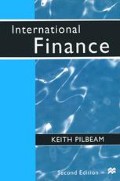Abstract
In Chapter 1 we looked at what exactly the foreign exchange market is, introduced a number of differing exchange-rate concepts, and examined a simple current account model of exchange-rate determination. In this chapter we look at one of the earliest and simplest models of exchange-rate determination, known as purchasing power parity (PPP) theory. An understanding of PPP is essential to the study of international finance, and the theory has been advocated as a satisfactory model of exchange-rate determination in its own right, providing a point of reference for the long-run exchange rate in many of the modern exchange-rate theories which we examine in later chapters.
Preview
Unable to display preview. Download preview PDF.
Selected Further Readings
Balassa, B. (1964) ‘The Purchasing Power Parity Doctrine: a Reappraisal’, Journal of Political Economy, vol. 72, pp. 584–96.
Cassell, G. (1928) Post-war Monetary Stabilization (New York: Columbia University Press).
Dornbusch, R. (1976) ‘Expectations and Exchange Rate Dynamics’, Journal of Political Economy, vol. 84, pp. 1161–76.
Dornbusch, R. (1987) ‘Purchasing Power Parity’, in the New Palgrave Dictionary of Economics (London: Macmillan).
Frenkel, J. A. (1981) ‘The Collapse of Purchasing Power Parities during the 1970s’, European Economic Review, vol. 16, pp. 145–65.
Frenkel, J. A. and Mussa, M. (1980) ‘The Efficiency of Foreign Exchange Markets and Measures of Turbulence’, American Economic Review, vol. 70, pp. 374–81.
Genberg, H. (1978) ‘Purchasing Power Parity under Fixed and Flexible Exchange Rates’, Journal of International Economics, vol. 8, pp. 247–76.
Hakkio, C. S. (1984) ‘A Re-examination of Purchasing Power Parity’, Journal of International Economics, vol. 17, pp. 265–77.
Isard, P. (1977) ‘How Far Can We Push the Law of One Price?’, American Economic Review, vol. 67, pp. 942–8.
Katseli, L. and Papaefstratiou, L. T. (1979) ‘The Re-emergence of the Puschasing Power Parity Doctrine in the 1970s’, Princeton Special Papers in International Economics, No. 13.
Lothian, J. (1997) ‘Multi-country Evidence on the Behaviour of Purchasing Power Parity under the Current Float’, Journal of International Money and Finance, vol. 16, no. 1, pp. 19–35.
MacDonald, R. (1980) Floating Exchange Rates: Theory and Evidence (London: Unwin Hyman).
Manzur, M. (1990)‘An International Comparison of Prices and Exchange Rates: a New Test of Purchasing Power Parity’, Journal of International Money and Finance, vol. 9, pp. 75–91.
Marston, R. C. (1986) ‘Real Exchange Rates and Productivity Growth in the United States and Japan’, Working Paper No. 1922, National Bureau of Economic Research.
Officer, L. (1976) ‘The Purchasing Power Parity Theory of Exchange Rates: A Review Article’, IMF Staff Papers, vol. 23, pp. 1–61.
Officer, L. (1986) ‘The Law of One Price Cannot be Rejected: Two Tests Based on the Tradeable/Non-Tradeable Goods Dichotomy’, Journal of Macroeconomics, vol. 8, pp. 159–82.
Samuelson, P. (1964) ‘Theoretical Notes on Trade Problems’, Review of Economics and Statistics, vol. 46, pp. 145–54.
Author information
Authors and Affiliations
Copyright information
© 1998 Keith Pilbeam
About this chapter
Cite this chapter
Pilbeam, K. (1998). Purchasing Power Parity and Floating Exchange-rate Experience. In: International Finance. Macmillan Texts in Economics. Palgrave, London. https://doi.org/10.1007/978-1-349-26630-2_6
Download citation
DOI: https://doi.org/10.1007/978-1-349-26630-2_6
Publisher Name: Palgrave, London
Print ISBN: 978-0-333-73097-3
Online ISBN: 978-1-349-26630-2
eBook Packages: Palgrave Economics & Finance CollectionEconomics and Finance (R0)

